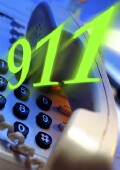
THURSDAY, May 13 (HealthDay News) — Most people aren’t familiar with the symptoms of a stroke and most who are wouldn’t do the right thing and call 911 if a stroke occurred, a new survey finds.
“If you know the stroke symptoms and don’t know how to react once you see them, that doesn’t do you much good,” said study author Chris Fussman, an epidemiologist with the Michigan Department of Community Health in Lansing.
His team will publish its findings online May 13 and in the July print issue of Stroke.
The survey asked more than 4,800 adults to report their reactions to five symptoms, three typical of a stroke (sudden slurred speech, sudden numbness on ode side of the body, sudden blurry vision), two unrelated to strokes (high fever, an injured leg).
Less than 28 percent of those surveyed knew all three stroke warning symptoms, and only about 18 percent of those who recognized the three symptoms said they would call 911.
The results were somewhat better when the answers were calibrated for single symptoms, with 51 percent of those in the survey saying they would call 911 for someone having trouble speaking or understanding, 42 percent making that call for sudden weakness or numbness on one side of the body and 20 percent saying they would do so for someone with sudden trouble seeing out of one or both eyes.
“All of these are recognizable and important,” Fussman said.
But the most common response to a stroke symptom was the wrong one — taking the affected person to an emergency room, rather than calling for an ambulance through 911.
“People don’t realize why we want to get medical help there as quickly as possible,” said Dr. Keith Siller, medical director of the New York University Comprehensive Stroke Care Center in New York City. “We need to treat these patients as quickly as possible. The best way to do that is not to drive a family member to an emergency room yourself but to get paramedics there quickly.”
First treatment for a stroke is injection of a clot-dissolving drug, tissue plasminogen activator (tPA). The time window in which tPA can dissolve a clot blocking a brain artery is narrow, 4.5 hours at most, Siller said, and the fastest way to get that treatment started is to call 911.
In the Michigan survey, older people were more likely to dial 911 in a stroke situation — 17.6 percent of those between 65 and 74, compared to 6.1 percent of those aged 18 to 24.
It’s not possible to say whether the Michigan results are typical of the entire country, Fussman said. “Studies in other states have shown quite a large range, so it is hard to tell if we are representative of the nation as a whole,” he said.
For example, one study of upstate New York found that between 33 percent and 72 percent of people would dial 911 if presented with stroke symptoms. Another found that between 41 percent and 51 percent of Montana residents would take the right action.
Educational programs can improve the public response to strokes, Siller added. The correct response to heart attacks has improved over the years as such programs have made people aware of heart attack symptoms and the need to get quick care by calling 911, he pointed out.
“We need to have the same mindset for strokes as for heart attacks,” Siller said.
More information
There’s more in how to recognize and react to stroke or heart attack at the American Heart Association.

